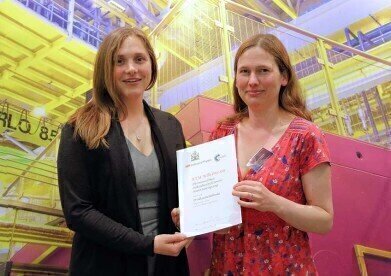-
 Aleksandra Dabkowska (left) receiving the 2015 Willis Prize from Katherine Thompson (Secretary of the Institute of Physics and Royal Society of Chemistry Neutron Scattering Group). (Credit: STFC/Philip King)
Aleksandra Dabkowska (left) receiving the 2015 Willis Prize from Katherine Thompson (Secretary of the Institute of Physics and Royal Society of Chemistry Neutron Scattering Group). (Credit: STFC/Philip King)
News & Views
Research at ISIS Leads to Neutron Scattering Prize
Aug 17 2015
A project on drug and gene delivery systems at STFC’s ISIS neutron source tipped to have important implications for new medicines, has won a young researcher the B.T.M Willis Prize for neutron scattering.
Dr Aleksandra Dabkowska used ISIS, a facility that allows research to see things on a scale ten thousand times thinner than a human hair, to probe the structure of model biological membranes. The aim was to aid the study of key biological processes such as protein interactions and DNA transfection that can impact drug efficiency, for example.
Dr Dabkowska beat six other nominees to become the seventh winner of this prestigious award which is given each year by the Neutron Scattering Group of the Institute of Physics (IOP) and the Royal Society of Chemistry (RSC) in recognition of outstanding contributions to neutron scattering science.
Dr Dabkowska, who is currently doing a Postdoc at Sweden’s Lund University but undertook much of her award-winning work as a Fellow in the Pharmaceutical Biophysics Group at King’s College London, said:
"I’m extremely honoured to have received the B.T.M. Willis Prize. Access to ISIS has been very useful in my work and has helped to fill in many question marks about biological interfaces. ISIS offers excellent instruments, great support and a collaborative atmosphere. In winning the prize, I’m very grateful for valuable help from colleagues and collaborators."
Her work has significantly benefited from using neutron reflectometry, and ISIS instruments such as SURF, CRISP and INTER have played an important role. Model biological membranes are built up of many molecules and neutron reflectivity in particular provides unique information about their structure that cannot be obtained through other techniques. Crucially, it can help generate a better understanding of how molecules are arranged even when their interfaces are submerged or buried between materials.
Digital Edition
Lab Asia 31.2 April 2024
April 2024
In This Edition Chromatography Articles - Approaches to troubleshooting an SPE method for the analysis of oligonucleotides (pt i) - High-precision liquid flow processes demand full fluidic c...
View all digital editions
Events
May 05 2024 Seville, Spain
InformEx Zone at CPhl North America
May 07 2024 Pennsylvania, PA, USA
May 14 2024 Oklahoma City, OK, USA
May 15 2024 Birmingham, UK
May 21 2024 Lagos, Nigeria










.jpg)






